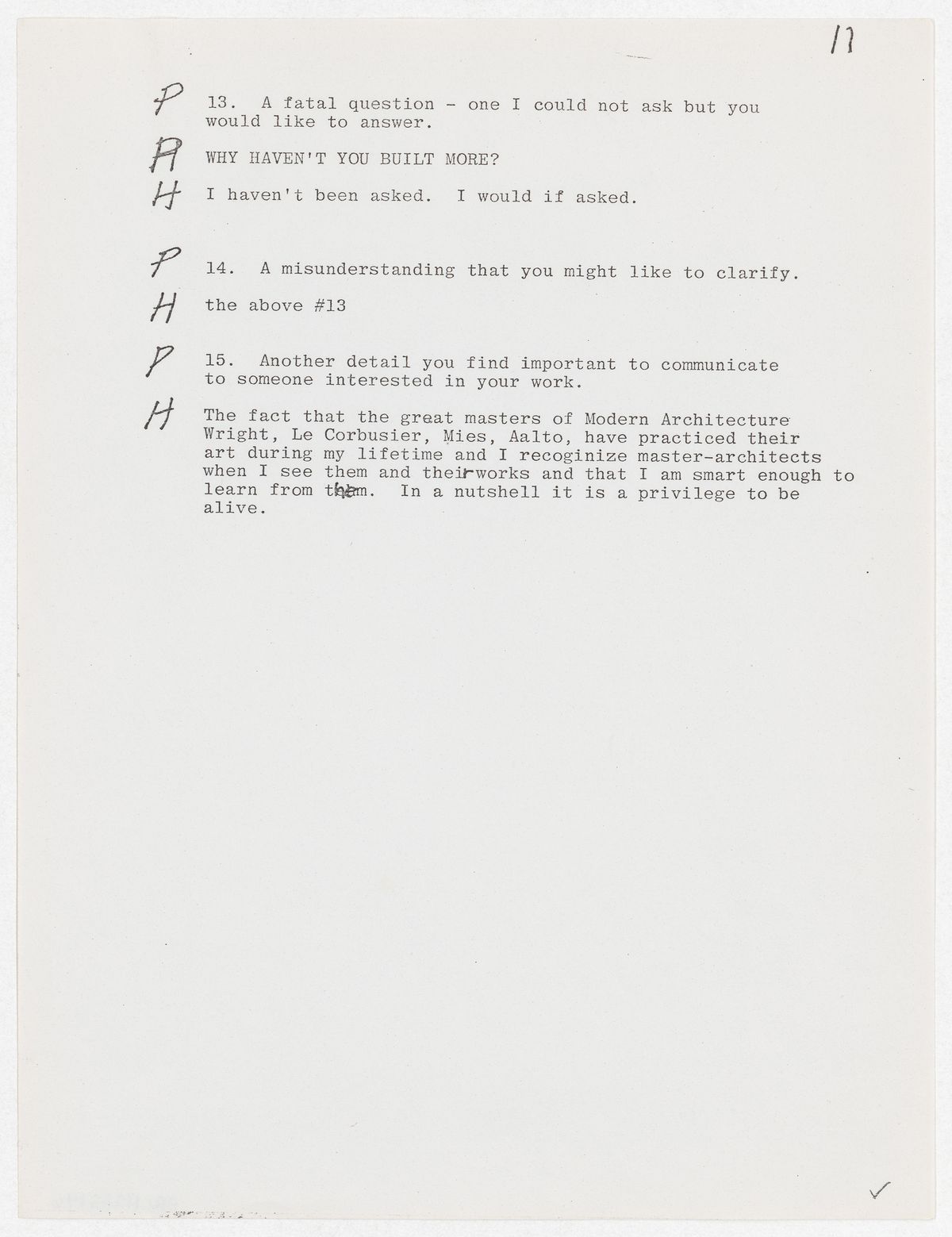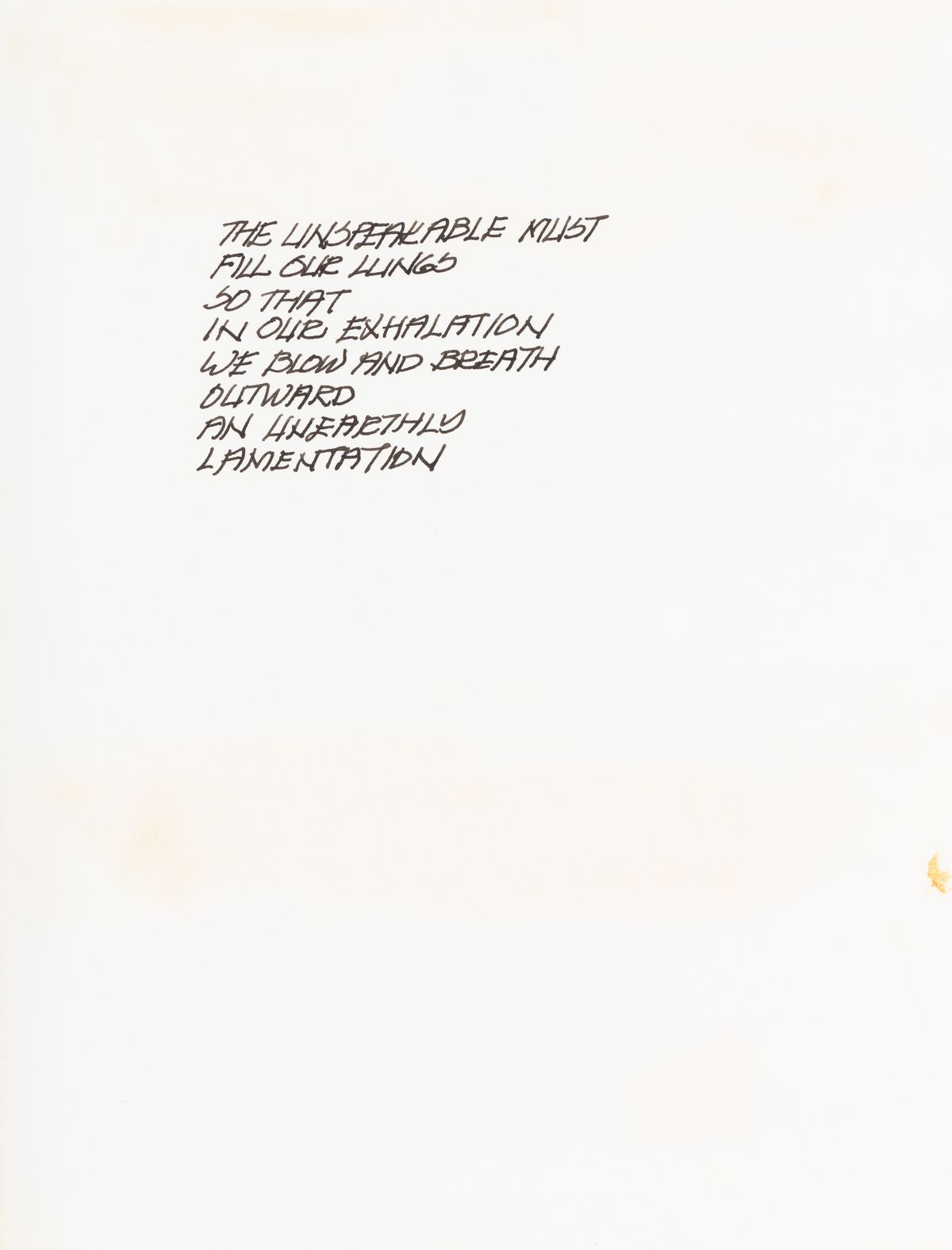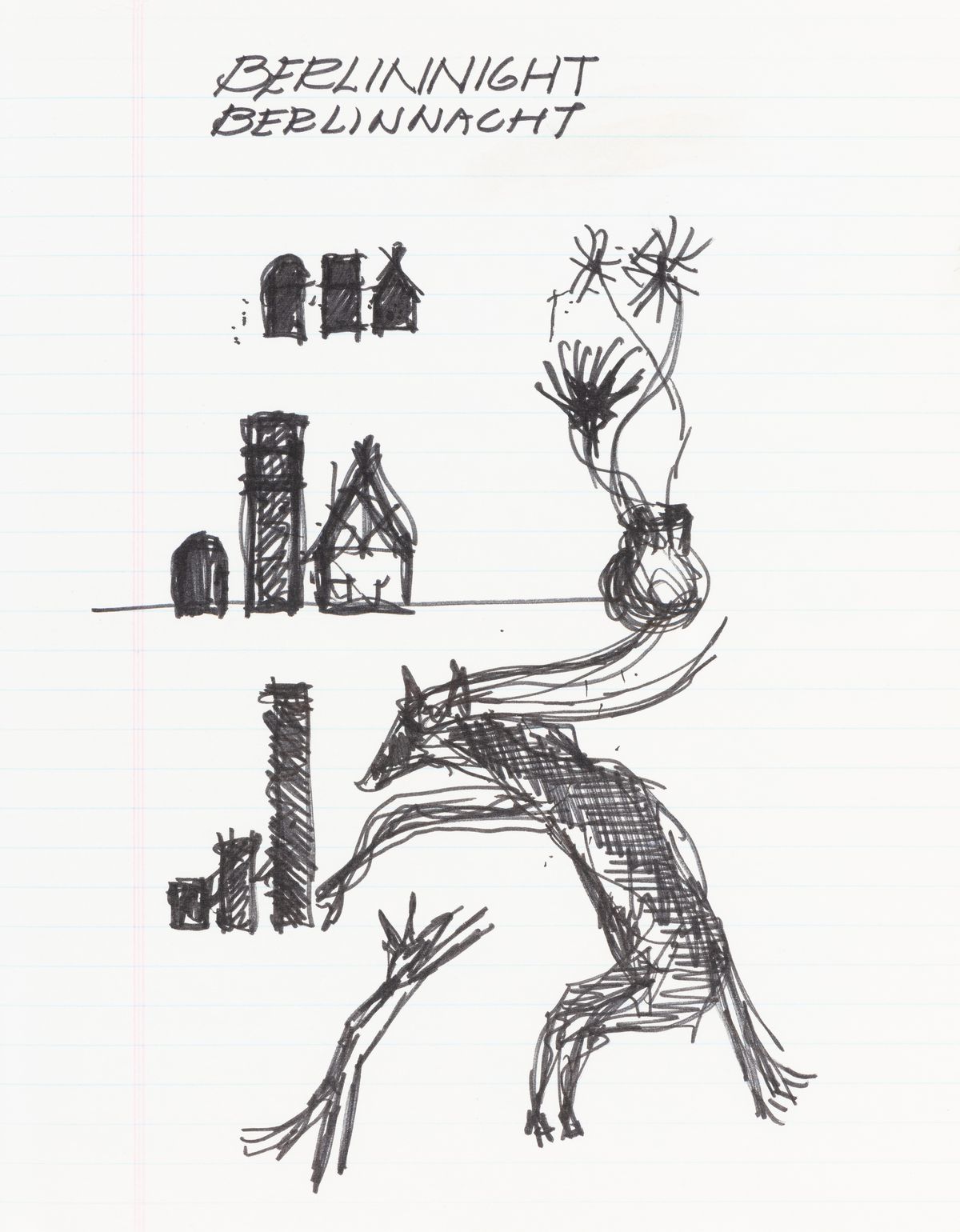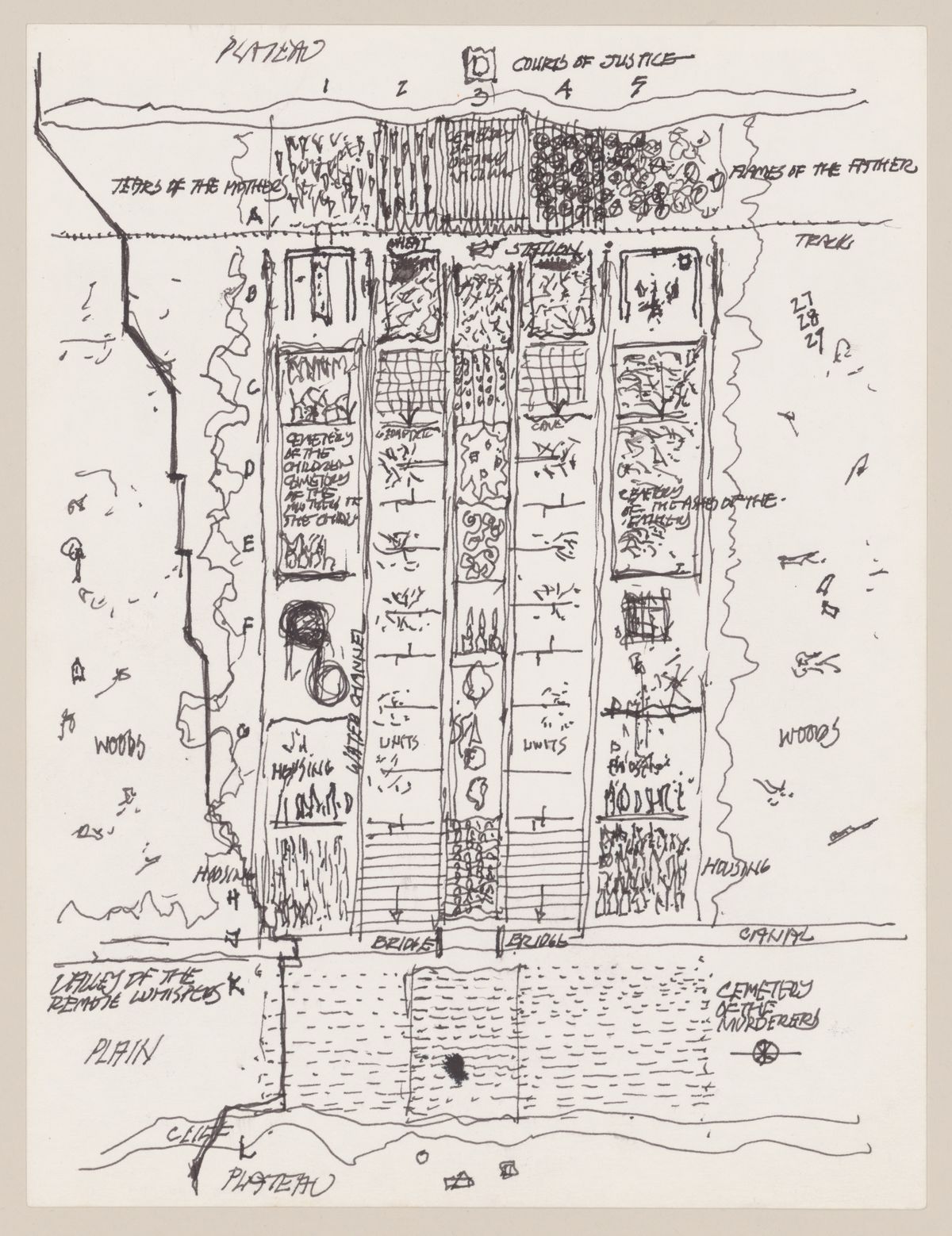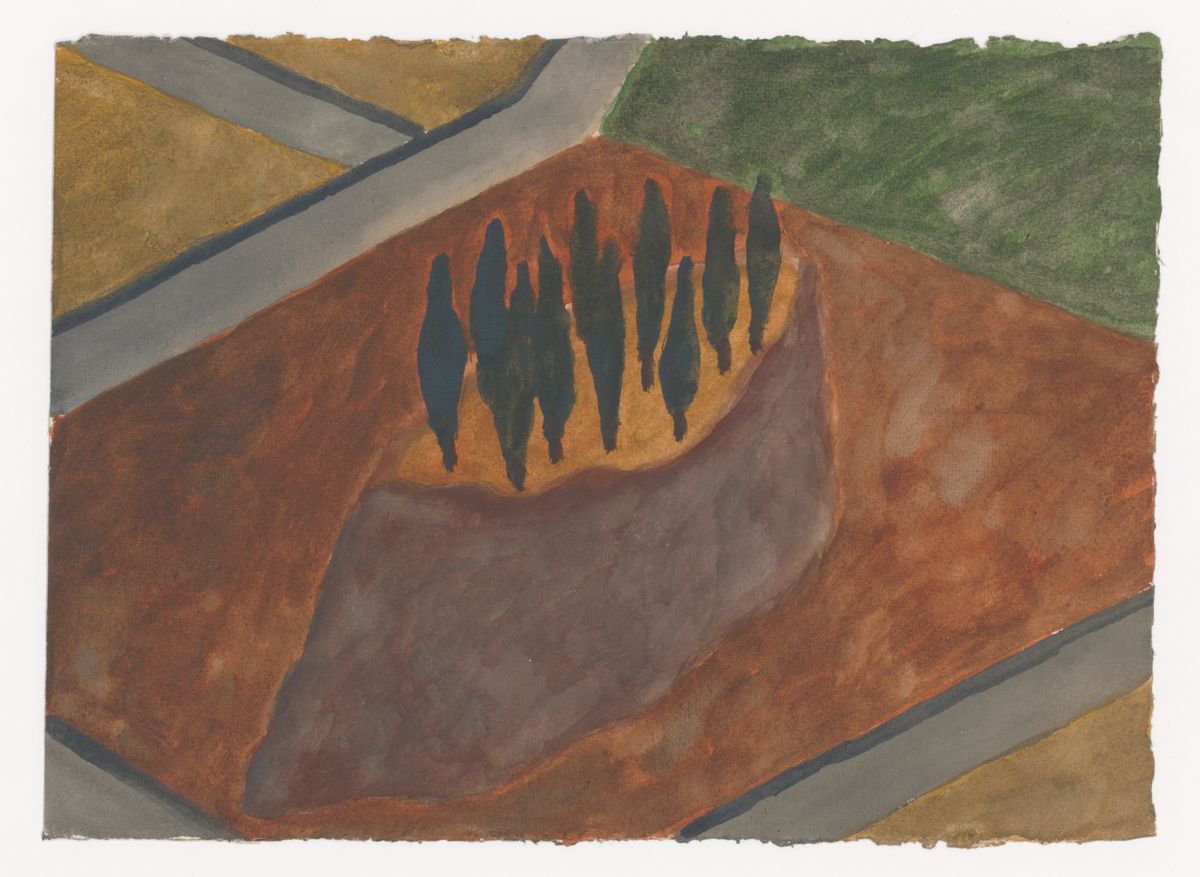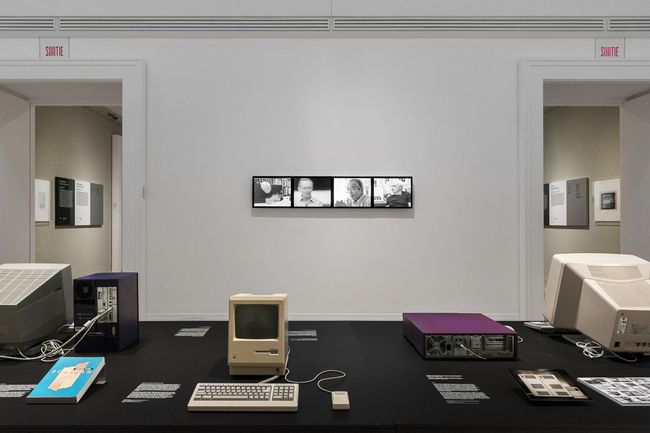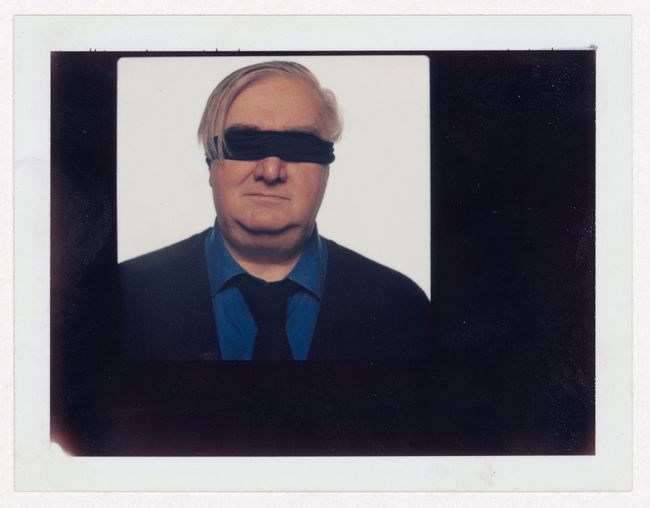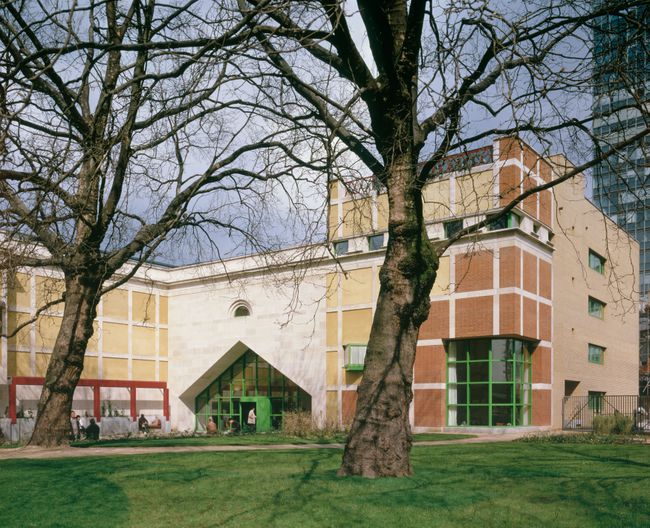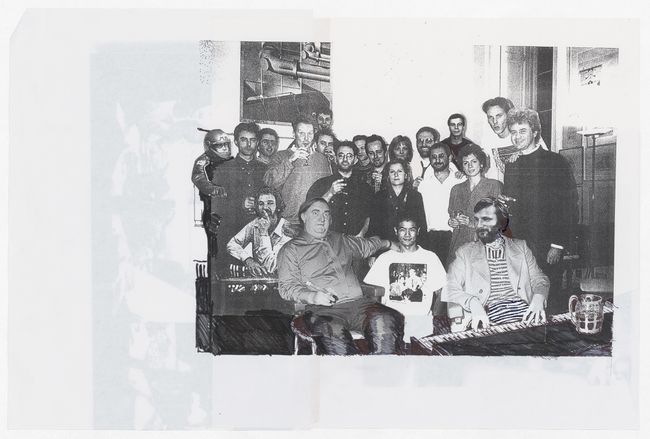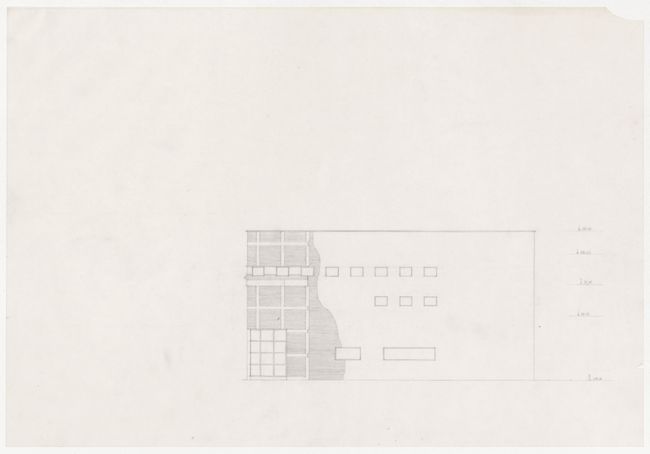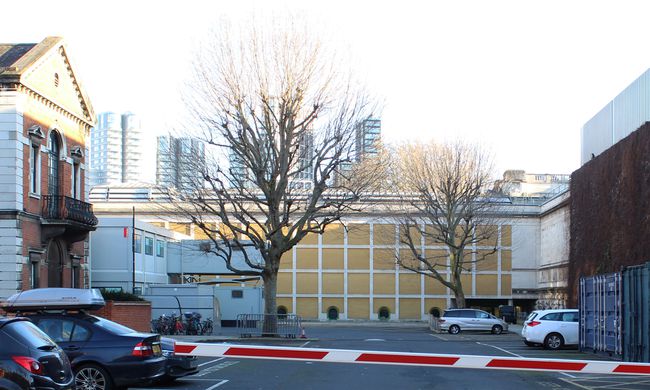In the Scale of... a gesture, a discourse, a joke
Aurelie Dupuis, Hanan Kataw, and Katerina Zacharopoulou
This is the second installment of “In the Scale of…,” a series of counterproposals to conventional constructs of scale, authored by the participants of our 2020 Toolkit for Today and introduced by Émélie Desrochers-Turgeon and Eliyahu Keller in this article. In the following texts, Aurelie Dupuis points out John Hejduk’s use of gesture, Hanan Kataw challenges the scaleless discourse of Western architecture as universal, and Katerina Zacharopoulou contextualizes James Stirling’s humour. Each author considers how architecture practice positions itself in the world through a linguistic and narrative manoeuvre of scale.
In the Scale of a Gesture
Aurelie Dupuis
John Hejduk’s late work on memory, in certain places emblematic of the violent historical dynamics that run through the twentieth century, has been widely received by architecture historians as a kind of theoretical meditation on architecture1—a reading of the work that reinforces the sense of opacity one may have when encountering for the first time the thousands of drawings present in the CCA’s John Hejduk fonds. The prolific architectural poetics that he developed throughout his life as well as the disciplinary context in which he worked have contributed to this reception.2 Yet, fragments of interviews and texts from that late period reveal Hejduk to have been a practitioner grappling with reality, not finding sufficient opportunity to build, and seeking to propose “programs for his time.”3 He was, in fact, exploring the capacity of his discipline to participate in a multi-layered reparative effort within a society facing deep trauma related to wars and recessions.4
Today, there is an urgent need for Western-trained architects to confront the (absence of) traces and consequences of colonial domination and to engage more actively with the memory and traumatic dynamics of place. In the face of obvious yet fragile entanglements between memories, histories, bodies, and places, it is not only a dominant narrative but an entire Western epistemic construction that is unsettled and confronted with its own inability to engage with the multidimensional relationalities of the planetary field. To reckon with the depth of the cracks in history, historians must reformulate the Western conception of time and duration in space, such that it ceases to separate past, present, and future, virtual and real, fact and fiction.5 Is the opposition between, on one hand, Hejduk’s declared commitment to the present and, on the other, the profusion of images, poems, and fictional elements, not itself partly a product of a linear conception of time? Wouldn’t it be more productive to consider his entire practice as an active architectural weaving of temporalities?
“The past is not past.” These words traced in the sketchbook for Soundings, one of Hejduk’s last projects, invite us to receive his late works as attempts to breach linear time by refusing to relegate the past as dead. In previous projects, architectural elements already occupy the breach between the real and the virtual.6 Never really image, never really architecture, elements are superimposed on the overdetermination of places of distress. But in his later projects, Hejduk seems to insist on another aspect of the interweaving of time, previously more latent. In the long description of Pewter Wings Golden Horns Stone Veils, he makes figures go through these layered landscapes with, as a culminating motif, the experience of an increased bodily attention to absence: “They both feel the silence.”7 Hejduk points here to the architectural understanding of a specific material dimension of the present, that of a silent past that continues to act in the present by finding access to materiality in bodies and gestures.8
At this point, architecture acts at the spatio-temporal scale of gesture. By touching on the intertwining of temporalities that play out in bodies, the gesture extends its action across time—towards the past, but also towards the future. When the past finds a way to reappear in an affective landscape of gestures, places, and relationships, it is not the isolated fact of the past that is recovered, but all the virtualities that surround it, tied to what has not been completely swept away from history. Gestures perform relationships and construct spatialities both as sites of repetition of a specific violence, and as potential means of subversion.9 Hejduk’s last projects can be seen as an architectural attempt to grasp the scale of this space of affective friction—and potential reparation.
-
The perception of Hejduk’s work as theoretical mediation has often been mentioned. Hejduk himself wrote, “There were friends/enemies who said: ‘Oh, John Hejduk, he’s a good teacher and a theorist, but he hasn’t built much.’” Bart Goldhoorn, Schools of Architecture (New York: Distributed Art Publishers Inc., 1997), 13. And from an article published after Hejduk’s death: “He was an architect who largely abstained from conventional practice, and the bulk of his work consisted of theoretical projects, executed in the form of drawings that were combined into poetic, often highly personal narratives.” Herbert Muschamp, “John Hejduk, an Architect and Educator, Dies at 71,” The New York Times, 6 July 2000, https://www.nytimes.com/2000/07/06/arts/john-hejduk-an-architect-and-educator-dies-at-71.html. ↩
-
Jordan Kauffman, Drawing on Architecture (Cambridge, MA: The MIT Press, 2018), 31. These years were ones whereby the architectural drawing was emancipated, becoming a project in itself beyond its relationship to the built work, and was given a place in art collections, especially in New York City. ↩
-
John Hejduk, interview by Reima Pietilä, 1980. ARCH285196, IAUS fonds, CCA. John Hejduk, Mask of Medusa: Works 1947–1983 (New York: Rizzoli International, 1989), 129. ↩
-
Hejduk’s projects address the inscription of the architectural project in contexts deeply impacted by World War II, the use and image of nuclear weapons, or the later processes of mass deindustrialization. He considers the task of repair not only in terms of the built substance of architecture but also in terms of atmosphere, embracing the complexity contained in this term. ↩
-
On the violence connected to the separation between past and present, see Ariella Azoulay, Potential History: Unlearning Imperialism (London: Verso, 2019). On the necessity to consider how fictional sources act in the present, see Anne Gilliland and Michelle Caswell, “Records and Their Imaginaries: Imagining the Impossible, Making Possible the Imagined,” Archival Science 16 (2016): 53–75; Yves Citton, “Could deep fakes uncover the deeper truth of an ontology of the networked images?” Nordic Journal of Aesthetics 30, no. 61–62 (2021): 46–64. ↩
-
Between 1974 and 1989, Hejduk developed several projects that he came to refer to as “masques.” These projects take the form of a series of books, each related to a city or community. In these masques, inspired by a Renaissance theatrical device, a series of architectural structures as well as a series of narrative elements related to them are described. This fictional ensemble operates at the level of spatialities, of narratives and relationships of a place. ↩
-
John Hejduk, Pewter Wings Golden Horns Stone Veils (New York City: The Monacelli Press, 1997), 12. ↩
-
Many researchers and artists are now focusing on materialities that have been neglected and ignored by Western epistemic constructions. A large part of this work concerns the persistence and reappearance of oral or gestural knowledge. See Carrie Noland, Sally Ann Ness, eds., Migrations of Gesture (Minneapolis: Minnesota University Press, 2008); Gabriele Schwab, Haunting Legacies: Violent Histories and Transgenerational Trauma (New York City: Columbia University Press, 2010); Rebecca Schneider, “Performance Remains,” Performance Research 6 (2001): 100–108; André Lepecki, “The Body as Archive: Will to Re-Enact and the Afterlives of Dances,” Dance Research Journal 42, no. 2 (2010): 28–48. ↩
-
On the deeply political and subversive dimension of gesture, see André Lepecki, “Choreopolice and Choreopolitics: Or, the Task of the Dancer,” The Drama Review 57, no. 4 (Winter 2013): 13–27. ↩
In the Scale of a discourse
Hanan Kataw
The increased use of computers for design brought about two crises of scale in architecture. The first crisis was hailed as such when, in the 1990s, scaleless, floating three-dimensional models and digitally optimized forms challenged the traditional understanding of tectonic and formal hierarchies. The second, less conspicuous, crisis was that of the scaleless discourse: a long-established practice wherein Western architecture is rendered without a scale—assumed universal—while other architectures and their discourses are necessarily bound to their geographical and cultural scales—partial and regional. While this critique of Eurocentric architecture discourse of the twentieth century is well-known, the crisis of the scaleless discourse is far from being resolved. At the turn of the twenty-first century, as the discipline was just beginning to confront these biases, a new digital discourse was being built on the same fallacy of the scaleless West.
The early international exhibitions on digital technology and architecture, including, for example, Non standard Architectures at the Centre Pompidou, Paris (2003–2004), almost exclusively showcased works by Western European and North American architects. In fact, browsing through the early histories of the digital in architecture, one gets the impression that computers did not exist outside the West. The limited geographic scale is not the issue here; the issue is that this focus went unacknowledged, allowing the West to stand in for the world. Hence, when in 2013 the CCA launched Archaeology of the Digital, for which it had acquired and documented twenty-five architecture projects produced between the late 1980s and early 2000s, the selection mirrored the already existing bias in the discourse and as such comprised projects designed predominantly by Western European and North American architects.1 However, as Mirko Zardini explained when Archaeology of the Digital was launched, “there was a sense of urgency in trying to capture this period, particularly because digital materials produced as part of the twenty-five projects were growing increasingly difficult to access as older forms of software became incompatible with new machines.”2 The CCA’s response to this urgency and its now rich born-digital collection, although initially Eurocentric, have been key for advancing the scholarship on the history of the digital in architecture. In recent years, many scholars, such as Daniel Cardoso Llach, and institutions, including the CCA, have since been working to expand the boundaries of the discourse and multiply the histories it includes. Although a lot of work still needs to be done, a broader understanding of the history of the digital in architecture has been slowly emerging.
That said, as important as these urgent responses are for the preservation of the histories of architecture, they are also most telling of the larger conditions and biases underlying how we—the designers, builders, historians, critics, and curators that are the architecture discipline—assign value to certain architecture. Unless we revisit these biases, rendering visible the institutional infrastructure guiding the selections and conditioning the narratives of our work, we will continue to perpetuate scaleless discourse and to produce biased histories, belatedly attempt to expand them, and then reproduce them once again.
-
The very few non-North American or Western European architects included in the project had by then already been affiliated with an Anglo-American architecture institution in a previous stage in their career, and hence already been part of the “scaleless” world of Western architecture. ↩
-
Mirko Zardini, “Eight Million Stories,” in When Is the Digital in Architecture?, ed. Andrew Goodhouse (Berlin: Sternberg Press, 2017), 8. ↩
In the Scale of a Joke
Katerina Zacharopoulou
Photographer unknown, Portrait of James Stirling, ca. 1973–1992. Chromogenic colour print, 8.5 × 11 cm. AP140.S2.SS7.D1.P3.015, James Stirling/Michael Wilford fonds, CCA
This portrait of a blindfolded Stirling is one of many humourous representations of him, including distorted statues and manipulated portraits, found in the architect’s archive at the CCA. Such depictions encourage the perception of Stirling as an individual with a sense of humour.
Discussions on humour, as a quality of either architects or buildings, are rarely brought to the forefront of architectural criticism. James Stirling, however, is an exceptional case. Through anecdotes, photographs, and graphic and sculptural representations in publications and archives, Stirling is painted as an individual with a strong sense of humour. In one of the many monographs on the architect and his partners, author Geoffrey Baker even dedicates a small section to Stirling’s humour—in fact, it is among the rare books on architecture that features the word humour in its index. For instance, Baker refers to the architect’s use of nicknames for critics, his interventions on models, and his impressions and funny faces in official contexts.1 In these depictions of Stirling’s words and actions, Baker constructs the architect’s identity as an exception—humour was a tool to attack the elitist image of the architecture profession.
-
Geoffrey H. Baker, The Architecture of James Stirling and His Partners James Gowan and Michael Wilford: A Study of Architectural Creativity in the Twentieth Century (Ashgate, UK: Surrey, 2011), 344–345. ↩
The entrance facades of the Clore Gallery, designed by Stirling, Wilford and Associates. Alastair Hunter, Clore Gallery, London, England, ca. 1978–1986. Colour transparency, 9.2 x 11.6 cm. AP140.S2.SS1.D60.SD1.P193.2, James Stirling/Michael Wilford fonds, CCA. © Alastair Hunter/RIBA
The entrance to the Clore Gallery is the part of the building that dominated media coverage at the time, along with some critics’ thematization of its humour. The square grid, disrupted at the right corner, was a source of amusement for John Summerson.
The frequent connection between Stirling and humour in architectural criticism does not stop at his personality but has been translated to his work as well. Clore Gallery, an extension to the Tate Britain by Stirling, Wilford and Associates, is an interesting example. Not long after its completion in 1987, the building sparked a discussion on humour in the British architecture press.1 In the way the gridded cladding on the façade is disrupted, the seemingly unsupported elements, and the references to the pre-existing Tate, critics saw a series of intentional—humorous—assaults on the presumed order of an autonomous building.
-
John Summerson, “Vitruvius Ridens or Laughter at the Clore,” The Architectural Review 181, no. 1084 (1 June 1987): 45–46; Peter Blundell Jones, “Stirling’s Last Laugh,” Architects’ Journal 186, no. 29 (22 July 1987): 32–44. ↩
Humorous group portrait of James Stirling, Michael Wilford and office personnel, Temasek Polytechnic, Singapore, ca. 1974–1999. Collage with ink of paper, 41 x 62 cm. AP140.S2.SS1.D97.P95, James Stirling/Michael Wilford fonds, CCA
In images of Stirling, Wilford and associates, it is not only Stirling, but his colleagues as well who are represented as having a sense of humour. Here, humour can be seen as a result of being together.
Stirling’s humour, as viewed so far in criticism, disrupts the way architects are conventionally represented and twists established rules of composition. However, the critical focus on the scale of the individual still reinforces the conception of the architect as a single, superior author, an author in control of even seemingly accidental, humorous moments. A look at the James Stirling/Michael Wilford fonds held at the CCA provides the opportunity to expand this scale. Although the archive is dominated by images of Stirling, depicting him as the lead figure of his office, further images also reveal what is absent from the usual representation of him as a humorous individual: his colleagues. Photographs and collages from life at the office, and events, parties, and trips are an indication that Stirling’s humour did not exist in a vacuum. It was allowed to thrive, and perhaps encouraged, within a collective.
James Stirling, Elevation for alternative design for Clore Gallery, London, United Kingdom, ca. 1978–1990. Graphite on translucent paper, 42 × 59.5 cm. AP140.S2.SS1.D60.SD1.P8.058, James Stirling/Michael Wilford fonds, CCA
Considering the abrupt and unusual changes of material in the finished building, the curved brickwork line shown in this drawing for an alternate side elevation of the Clore Gallery, could have been an actual consideration, rather than a graphic convention indicating continuous material. Or was it a joke?
This idea is mirrored in some of the development drawings of the Clore Gallery. We cannot always be certain of these drawings’ authors, and whether they constitute serious proposals, creative exercises, or even jokes between colleagues. What such drawings do reveal are moments of uncertainty, of unexpected connections and juxtapositions, that produce humour, which allows the possibility of error.
The finished building displays another side of architectural humour not considered by critics. The Clore Gallery was originally part of a larger project, a museum campus, eventually abandoned due to financial issues.1 The extension’s unfinished nature results in an occasionally humorous coexistence of intended and unintended incongruities, which blur the boundaries between the Clore Gallery as an authored object and its chaotic urban context.
Expanding the scale of the critical interpretation of humour can present it as the unpredictable collision of various agencies and accidental urban encounters, disrupting the image of the architect-author and, more profoundly, architectural authority.
-
David Jenckins, “The Five Tates,” and “Failing at Phase Three,” in Clore Gallery Tate Gallery, Liverpool: James Stirling, Michael Wilford and Associates (London: Phaidon, 1992). ↩
View of the Clore Gallery’s back entrance, London, United Kingdom, 2020. Photograph by Katerina Zacharopoulou
The back entrance of the building, initially designed to face a public sculpture garden, was ignored in the critical take of the building’s humour. The area now functions as a utilitarian space, featuring parking space, temporary constructions, and even garbage.
